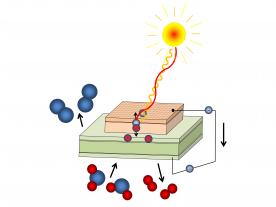The Vienna University of Technology has developed a novel photo-electrochemical cell, which can chemically store the energy of ultraviolet light at high temperatures.
Absorbing sunlight and chemically storing the energy is something that plants do all the time, but up till now there has been no human technology capable of doing it effectively. Photovoltaics converts light into electricity, which can then be used to produce hydrogen, but the process is significantly weaker than plant photosynthesis: First of all, the efficiency of conventional solar cells decreases at high temperatures. Secondly, the efficiency of the steps from energy absorption to hydrogen generation is limited.
The Institute for Energy Systems and Thermodynamics at the Vienna University of Technology has now developed a new concept that promises a lot of potential: By selecting special materials, it was possible to combine high temperature photovoltaics with an electrochemical element. It allows UV light to be used to pump oxygen ions through a ceramic electrolyte membrane, which in turn allows the energy of the UV light to be stored chemically. In the future, this method will allow water to be split into hydrogen and oxygen directly using sunlight. Both gases can then be stored for as long as necessary without energy loss and will then be available as raw materials or for generating energy on demand.
The new concept is based on the idea of combining hydrogen at high temperatures with photovoltaics – for example in a concentrator power plant. The PhD student Georg Brunauer at the Vienna University of Technology has now achieved a breakthrough with this technology. Instead of silicon-based photovoltaics, he used special perovskite mixed metal oxides that enabled him to build a cell that combines high-temperature solar power and electrochemistry.
First create voltage, then pump ions
"Our cell consists of two different parts: an upper photoelectric part and a lower electrochemical part," Georg Brunauer said. "In the upper layer, free charge carriers are produced by light, just like in an ordinary solar cell." The electrons are conducted to the lower side of the electrochemical cell, where they impart a negative charge to oxygen atoms, which can then migrate through the lower layer of the cell.
"This crucial photoelectrochemical step is the basis for subsequently splitting water and producing hydrogen," Brunauer explained. The preceding step, an oxygen pump that is powered by UV light, is already functional. At 400 °C, it supplies an open circuit voltage of up to 920 mV.
But the new concept is not only suitable for producing hydrogen. It can also be used to split CO2 to obtain CO, which is interesting for fuel synthesis. To ensure that the new invention is able to make the leap from the university laboratory to the implementation of a prototype, Georg Brunauer has started a new company by the name of Novapecc together with an industrial partner. The company has applied for patents together with the Vienna University of Technology.
